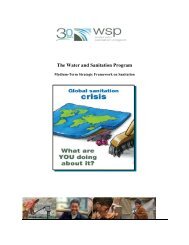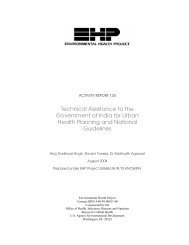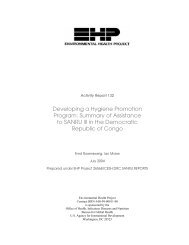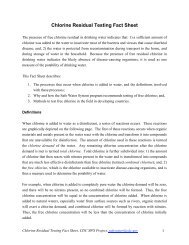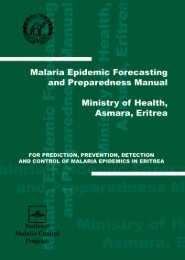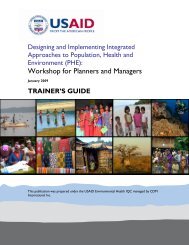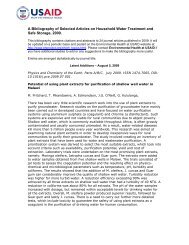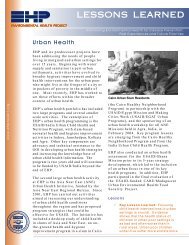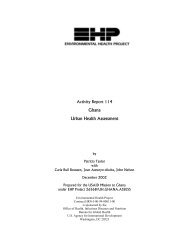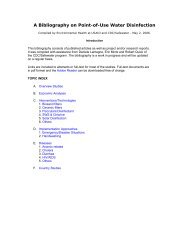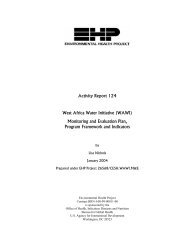Changing Glaciers and Hydrology in Asia - Environmental Health at ...
Changing Glaciers and Hydrology in Asia - Environmental Health at ...
Changing Glaciers and Hydrology in Asia - Environmental Health at ...
- No tags were found...
You also want an ePaper? Increase the reach of your titles
YUMPU automatically turns print PDFs into web optimized ePapers that Google loves.
Current Work on Issues Rel<strong>at</strong>ed to Glacier Melt/Retre<strong>at</strong> <strong>in</strong> <strong>Asia</strong>Appendix A.1 ‐ Ma<strong>in</strong> D<strong>at</strong>abaseOrganiz<strong>at</strong>ion DetailsName Key Contact Contact Details URLWWFIUCNCGIAR ChallengeProgram on Food<strong>and</strong> W<strong>at</strong>erJohn Miceler,Manag<strong>in</strong>g Director,Eastern HimalayasProgram. Also TariqAziz, Leader of WWFLiv<strong>in</strong>g HimalayaIniti<strong>at</strong>ive, Nepal.Also Shirish S<strong>in</strong>ha,Head, Clim<strong>at</strong>eChange <strong>and</strong> EnergyProgramme, WWF‐India; <strong>and</strong> DrDipankar Ghose,Eastern Himalaya<strong>and</strong> TeraiProgramme, WWF‐India.Mr. Ahmad SaeedPr<strong>in</strong>cipal ExpertGlobal ChangeNo specifictariq.aziz@wwfnepal.org,Jon.Miceler@wwfus.org;shirish@wwf<strong>in</strong>dia.net;dghose@wwf.<strong>in</strong>dia.netahmad.saeed@iucnp.orgwww.p<strong>and</strong>a.org,www.worldwildlife.org/wh<strong>at</strong>/wherewework/easternhimalayas/<strong>in</strong>dex.htmlGeographicArea of FocusEasternHimalayas(Nepal, Bhutan,northernMyanmar,southeast Tibet<strong>and</strong> northeastIndia)http://www.iucn.org/ Pakistan,about/union/secretar Nepal, Ch<strong>in</strong>ai<strong>at</strong>/offices/asia/regional_activities/elg/?712/F<strong>in</strong>d<strong>in</strong>g‐aworkableconserv<strong>at</strong>ion‐modelfor‐high‐altitudeecosystemshttp://cpwfbfp.pbworks.com/"Bas<strong>in</strong> FocalProject" <strong>in</strong> theIndo‐Ganges,Volta, YellowRiver &Mekong bas<strong>in</strong>sSubject Area of Focus <strong>and</strong>Expertise <strong>in</strong> Rel<strong>at</strong>ion toGlacial Melt Summary of Activities PartnersMostly adapt<strong>at</strong>ionfocused but also policyaspects <strong>and</strong> field researchaspects <strong>in</strong>clud<strong>in</strong>gmonitor<strong>in</strong>g retre<strong>at</strong> <strong>at</strong>river source areas on theTibetan pl<strong>at</strong>eau.Work<strong>in</strong>g withGovernment of Pakistanon clim<strong>at</strong>e‐rel<strong>at</strong>eddisaster management <strong>in</strong>PakistanAn <strong>in</strong>tern<strong>at</strong>ional, multi<strong>in</strong>stitutionalresearch<strong>in</strong>iti<strong>at</strong>ive with a strongemphasis on north‐south<strong>and</strong> south‐southpartnerships."Clim<strong>at</strong>e Change Impacts on Freshw<strong>at</strong>er Ecosystems <strong>in</strong> the Himalayas (CCIFEH)" projectbuilds on the 2 year Himalayan <strong>Glaciers</strong> <strong>and</strong> Rivers Project funded by WWF NL 2004‐6, whichdocumented the impact of clim<strong>at</strong>e change on glacier melt <strong>in</strong> the Himalayas. Builds on glacialresearch <strong>in</strong> the Indian <strong>and</strong> Nepali Himalayas <strong>and</strong> on the Tibetan Pl<strong>at</strong>eau <strong>and</strong> will l<strong>in</strong>k toongo<strong>in</strong>g freshw<strong>at</strong>er <strong>and</strong> species programme work <strong>in</strong> the Ganga Bas<strong>in</strong> of India. In Nepal, willimplement adapt<strong>at</strong>ion measures <strong>in</strong> Gokyo lake, <strong>and</strong> support the High Altitude Wetl<strong>and</strong>sproject <strong>in</strong> Ladakh, India.An Overview of <strong>Glaciers</strong>, Glacier Retre<strong>at</strong>, <strong>and</strong> Subsequent Impacts <strong>in</strong> Nepal, India <strong>and</strong>Ch<strong>in</strong>a. A detailed review <strong>in</strong> 2005 of glacial retre<strong>at</strong> <strong>and</strong> impacts <strong>in</strong> Nepal, India <strong>and</strong> Ch<strong>in</strong>a,which is <strong>in</strong> the process of be<strong>in</strong>g upd<strong>at</strong>ed.Monitor<strong>in</strong>g the glaciers of the Himalayas, Nepal. In both Nepal <strong>and</strong> Bhutan, WWF areundertak<strong>in</strong>g the follow<strong>in</strong>g:1. Monitor<strong>in</strong>g glacial retre<strong>at</strong> <strong>in</strong> areas th<strong>at</strong> dangerous glacial have formed2. Monitor<strong>in</strong>g upper w<strong>at</strong>ershed flows‐w<strong>at</strong>er quality, quantity <strong>and</strong> frequency changes3. Establish<strong>in</strong>g early warn<strong>in</strong>g systems for communities <strong>at</strong> risk from GLOFs.4. (Bhutan only): Manually reduc<strong>in</strong>g w<strong>at</strong>er levels <strong>in</strong> dangerous glacial lakes by h<strong>and</strong> throughdigg<strong>in</strong>g of trenches <strong>and</strong> pump<strong>in</strong>g w<strong>at</strong>er out. Also do<strong>in</strong>g a lot of village work <strong>in</strong> Bhutan <strong>and</strong>Nepal with communities liv<strong>in</strong>g near glaciers th<strong>at</strong> are reced<strong>in</strong>g <strong>and</strong> which have dangerousglacial lakes near them. In Tibet WWF's work focuses on:1. Clim<strong>at</strong>e witness work (community‐based adp<strong>at</strong><strong>at</strong>ion approach) where design<strong>at</strong>ed nomadsliv<strong>in</strong>g near glaciers <strong>and</strong> wetl<strong>and</strong> river source areas capacit<strong>at</strong>ed to report on changes <strong>in</strong>rangel<strong>and</strong> ecology, glacier shifts, we<strong>at</strong>her changes2. Basel<strong>in</strong>e monitor<strong>in</strong>g of certa<strong>in</strong> glaciers3. General community based adapt<strong>at</strong>ionH<strong>in</strong>du Kush‐Karakoram‐Himalaya regional project (ended mid‐2009): Aims to supportcapacity to underst<strong>and</strong>/manage high altitude ecosystems from a systems perspective.Focused on three protected areas: Sagarm<strong>at</strong>ha N<strong>at</strong>ional Park <strong>in</strong> Nepal, the Central KarakoramN<strong>at</strong>ional Park (CKNP) <strong>in</strong> Pakistan <strong>and</strong> Qomolangma N<strong>at</strong>ure Preserve <strong>in</strong> the Tibet AutonomousRegion of Ch<strong>in</strong>a.IUCN is support<strong>in</strong>g a number of specific activities <strong>in</strong>clud<strong>in</strong>g the developmentof a shared vision for the area through <strong>in</strong>nov<strong>at</strong>ive scenario plann<strong>in</strong>g tools; provid<strong>in</strong>g resourcebasel<strong>in</strong>es through GIS mapp<strong>in</strong>g <strong>and</strong> research; work<strong>in</strong>g to coord<strong>in</strong><strong>at</strong>e diverse actions <strong>and</strong><strong>in</strong>terests <strong>in</strong> the area; apply<strong>in</strong>g new plann<strong>in</strong>g <strong>and</strong> management tools such as Qualit<strong>at</strong>iveSystems Analysis <strong>and</strong> use of IUCN Protected Area C<strong>at</strong>egories <strong>in</strong> zon<strong>in</strong>g plans.Impact of Clim<strong>at</strong>e Change on W<strong>at</strong>er Resources <strong>and</strong> Glacier Melt <strong>and</strong> Potential Adapt<strong>at</strong>ions forIndian Agriculture.The CCIFEH project is acollabor<strong>at</strong>ive effort betweenWWF India <strong>and</strong> the BirlaInstitute fo technology,Extension Centre, Jaipur, India,who worked with the ForestDepartment, Government ofIndia. The Glacial Retre<strong>at</strong>public<strong>at</strong>ion is a jo<strong>in</strong>t effortbetween WWF Nepal, WWFIndia <strong>and</strong> WWF Ch<strong>in</strong>a. N<strong>at</strong>ionalGovernmental partners on thisproject <strong>in</strong>cluded DHM/MOEST<strong>in</strong> Nepal; HIGH ICE‐IndiaGlacier Research Group,Jawaharlal Nehru University(JNU), New Delhi, India; <strong>and</strong>the Ch<strong>in</strong>ese Academy ofSciences (CAS) <strong>in</strong> Ch<strong>in</strong>a. InNepal, work with Departmentof <strong>Hydrology</strong> <strong>and</strong> Meteorology(DHM) <strong>and</strong> TribhuvanUniversity.ICIMOD) <strong>and</strong> the Italian NGOCooperazione e Sviluppo(CESVI)Comments/Relevant Public<strong>at</strong>ions<strong>and</strong> ResourcesThe 2005 report "An Overview of<strong>Glaciers</strong>, Glacier Retre<strong>at</strong> <strong>and</strong>Subsequent Impacts" conta<strong>in</strong>sst<strong>at</strong>ements based on the nowcontroversial article from The NewScientist magaz<strong>in</strong>e "Flooded Out ‐Retre<strong>at</strong><strong>in</strong>g glaciers spell disaster forvalleycommunities" published 5 June1999. This article has recently beenexposed as conta<strong>in</strong><strong>in</strong>g erroneousst<strong>at</strong>ements rel<strong>at</strong><strong>in</strong>g to glacial meltclaims. A correction has been issuedby WWF. Other relevantpublic<strong>at</strong>ions <strong>in</strong>clude: Witness<strong>in</strong>gChange: <strong>Glaciers</strong> <strong>in</strong> the IndianHimalayas. 2009. WWF India <strong>and</strong>BIT.An Overview of <strong>Glaciers</strong>, GlacierRetre<strong>at</strong>, <strong>and</strong> Subsequent Impacts<strong>in</strong>Nepal, India <strong>and</strong> Ch<strong>in</strong>a. 2005. WWFNepal.Nb CIGAR is a coper<strong>at</strong>ive oforganiz<strong>at</strong>ions r<strong>at</strong>her than onespecificPractical ActionLiBirdNavdanyaGehendra Gurung(Nepal office)Apar Paudyal,programme officerDr. V<strong>and</strong>ana Shiva,Directorgehendra.gurung@practicala http://www.practical Nepalction.org.npaction.org/nepal/region_nepalapaudyal@libird.org,http://www.libird.org Nepal/ndana@v<strong>and</strong>anashiva.com / www.navdanya.orgv<strong>and</strong>ana.shiva@gmail.com /vshiva@vsnl.comTechnology focus, fromR&D through toimplement<strong>at</strong>ionCommunity‐basedadp<strong>at</strong><strong>at</strong>ion <strong>and</strong>developmentIndia, Himalaya Community‐basedadapt<strong>at</strong>ionPorjects on community‐based adp<strong>at</strong><strong>at</strong>ion, especially rel<strong>at</strong>ed to w<strong>at</strong>er management.Coord<strong>in</strong><strong>at</strong><strong>in</strong>g agency for the 2008 Nepal NGO Group Bullet<strong>in</strong> on Glacial Mel. Seehttp://www.forestrynepal.org/images/Clim<strong>at</strong>eChange_issue2_F<strong>in</strong>al.pdf.Over the last year, Navdanya / Research Found<strong>at</strong>ion teams have worked with localcommunities <strong>in</strong> Uttarakh<strong>and</strong> <strong>and</strong> Ladakh to assess the impact of clim<strong>at</strong>e change on theirecosystems <strong>and</strong> economies <strong>and</strong> to evolve community‐based adapt<strong>at</strong>ion ‐ particip<strong>at</strong>ory plansfor clim<strong>at</strong>e change adapt<strong>at</strong>ion.IIED; DfIDPeople's ScienceInstitute (PSI)Dr. Ravi Chopra,Directorpsiddoon@gmail.comwww.peoplessciencei Indianstitute.comResearch <strong>and</strong>development activities.Many activities aroundw<strong>at</strong>ershed managementKey stakeholders contacted by G.F. Taylor dur<strong>in</strong>g coutry visit.8



